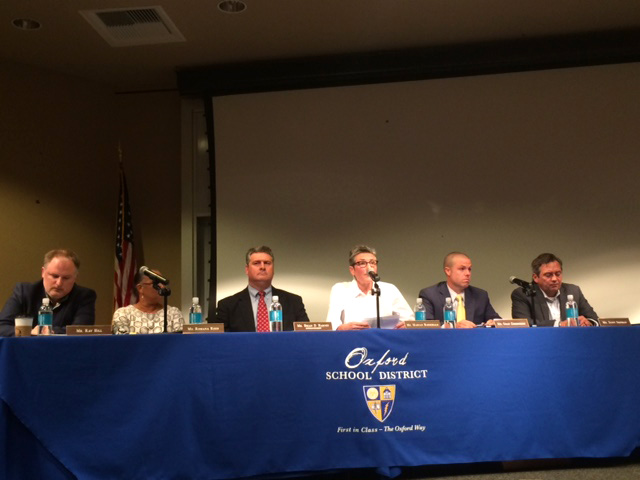Community members express concerns at Oct. 18 school board meeting
October 19, 2016
The Oxford School District Board of Trustees held a special public hearing on Tuesday night stemming from continued concerns regarding the recent article published in the Charger, in which a potential plan to create a separate school for low income students was discussed.
The hearing was initially requested by Pontotoc attorney Walter Zinn, who was hired to represent over 300 concerned parents and community members who had met and discussed concerns and issues that they had after the initial article was published. These issues included the achievement gap, the need for more transparency between the community and the board members, and lack of diversity among teachers and administrators in the district.
“The gathering tonight is one more step of many that the district will take to understand the issues that we have been hearing about and others that might be raised tonight,” School Board President Marion Barksdale said. “This is complicated, and we will all need to work together to figure out the best way for our community and school to address the issues.”
Zinn began by discussing the reason why he requested the hearing.
“We want to be forthright and assert that you have our attention,” Zinn said to the board. “How do we create and foster the dialogue that may have been encompassed in the article? From having read the article, there were several points that hinged on the issue of race, gender and poverty.”
Zin then yielded his time to three speakers that were chosen from the initial 300 concerned community members to address specific issues that the members had.
Jacqueline Certion began by criticizing the school board for the lack of diversity in the school system.
“There needs to be an increase of both racial and gender diversity among faculty and extracurricular diversity,” Certion said.
Certion also questioned the discipline action taken against minority students.
“When it coms to the implicit bias awareness, what have you done to look at the percentile breakdown of discipline actions taken towards students of color versus those of ethnic counterparts?” Certion asked.
Tori Marion White then addressed concerns community members had regarding the achievement gap and the approach the board is taking to alleviate this problem.
“We do believe there were not enough stockholders in the explorations and discussion of these strategies,” White said, regarding the achievement gap. “We feel that there needs to be a person whose full time job is dedicated to strategies to close the achievement gap.”
White then questioned the ULLC proposal initially discussed in the Charger article.
“Does the school board support the superintendent’s ideas about the ULLC model, and has this model been completely taken off the table?” White asked.
The third speaker was Daniel Mathias who discussed his disappointment in the comments and decisions made by the school board.
“You did something that was immoral,” Mathias said. “You didn’t check yourself. I’m sure every parent wants their kid to close their achievement gap, but you have to do better. Oxford is better than this. Don’t split our kids.”
Zinn followed these speeches by asking that the board to be more transparent with the community and create a more open communication between the school board and the public. Zinn also requested for the board to publicize the achievement gap numbers.
After the three speakers finished, Barksdale encouraged anyone from the audience to voice any other concerns that they had.
Volunteer 7th and 8th grade coach Pat Marr was a member of the audience who spoke and defended the school board. Marr admitted he did not read the article, but was still supportive of the board.
“I don’t think white and black was ever the issue,” Marr said. “From my understanding, there were several things that were brought up.”
Several other community members, including Alex Coleman and Latanyia Dixon, also voiced concerns they had, and continued to demand for a more diverse teacher population.
“If you have a person who stands in front of you who looks like you, then you can connect with them better,” Dixon said, regarding the need for more teachers of color.
After the hour allotted by the school board was over, Barksdale thanked the community members that attended. She said that the school board would include the community more to try to solve these issues.
“I would like to thank everyone,” Barksdale said. “I am speaking for myself, but I have learned a lot. I am encouraged that so many people are engaged with us. We will investigate, we will study, and include the community in the work that we do. We will try to solve the things that concern us and get better.”
Zinn plans to continue the conversation with the board.
“This is the first step,” Zinn said. “We are going to submit a list of recommendations and policy considerations, and then we will try to foster another conversation with them and a go over a timeline because some of the things that we are asking they can do right now.”



